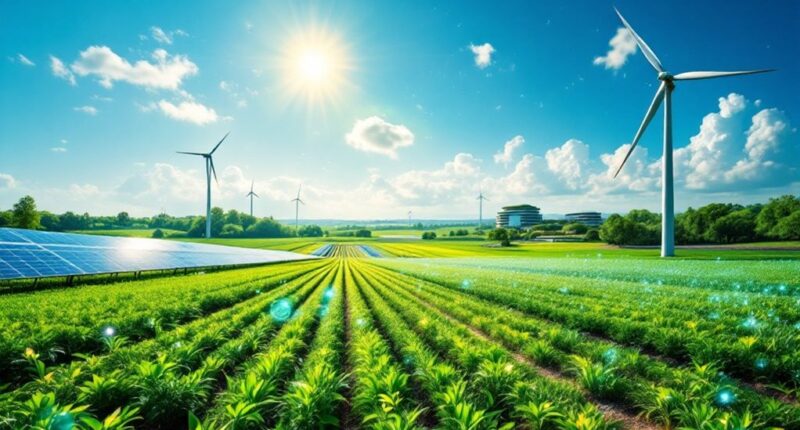AI is making waves in sustainability, especially in carbon management. It predicts energy usage like a weather forecast, helping us save up to 15% energy in data centers. Picture a smart grid, juggling renewable energy sources with finesse. AI is like a digital farmer, analyzing soil and optimizing irrigation for maximum crop yield. It even keeps tabs on our carbon footprints. Curious about how all these pieces fit together? There’s more to uncover in this fascinating interplay.

As the world grapples with pressing environmental challenges, it’s fascinating to see how artificial intelligence (AI) is stepping up to the plate like a superhero in a tech-fueled cape. These digital champions are transforming sustainability efforts across various sectors, proving that with the right algorithms, even Mother Nature can get a much-needed boost.
In energy optimization, AI predicts usage patterns in buildings and industries as if it has a crystal ball. This nifty technology can reduce energy consumption in data centers by up to 15%—that’s like finding a hidden stash of snacks in your pantry when you thought you were out. Additionally, AI enhances the integration of renewable energy into power grids, ensuring that the wind turbines spin more efficiently through predictive algorithms. Imagine a smart grid that manages energy distribution like a finely-tuned orchestra, each instrument perfectly timed to create harmony. AI’s energy consumption mirrors that of entire nations, highlighting the need for sustainable practices. Moreover, regular auditing of AI systems ensures that any biases are addressed, promoting responsible energy usage.
AI is revolutionizing energy use, predicting patterns and optimizing renewable sources for a harmonious, efficient grid.
In agriculture, AI acts like a digital farmer‘s best friend, analyzing soil data to predict crop yields and identifying pesky bugs before they can wreak havoc. It optimizes irrigation systems, reducing water waste, and keeps a keen eye on livestock health. Think of it as having a high-tech agricultural advisor that spares farmers from the guesswork, ultimately reducing food waste through smarter supply chains.
The climate modeling capabilities of AI are equally impressive. Processing vast amounts of climate data, it improves the accuracy of weather forecasts and detects deforestation with nearly 90% accuracy. It’s like having a weather-savvy friend who always knows when to pack an umbrella.
However, it’s crucial to recognize that AI isn’t without its challenges. Increased IT carbon emissions and electronic waste remind us that even superheroes have weaknesses. Despite these hurdles, AI remains an invaluable tool in the quest for sustainability, proving that with clever tech and a dash of human ingenuity, a greener future may just be a few algorithms away.
Frequently Asked Questions
How Does AI Improve Renewable Energy Sourcing and Usage?
AI greatly enhances renewable energy sourcing and usage by optimizing various processes. It forecasts energy demand and integrates renewable sources like solar and wind more effectively, much like a conductor leading an orchestra. Predictive maintenance guarantees equipment runs smoothly, reducing downtime—nobody likes a cranky wind turbine.
Additionally, AI refines site selection for new projects, guaranteeing they are both efficient and cost-effective. It’s like choosing the perfect spot for a picnic, minus the ants and sunburn.
Can AI Predict Climate Change Impacts on Local Ecosystems?
AI can indeed predict climate change impacts on local ecosystems with impressive precision. By analyzing data from satellites and sensors, it identifies shifts in biodiversity and tracks species movements like a nature detective.
Imagine being able to forecast which plants might thrive or wither in changing climates This technology enables proactive conservation efforts, ensuring that vulnerable species get the help they need, all while turning complex data into actionable insights—like turning weather forecasts into a survival guide for nature.
What Role Does AI Play in Sustainable Agriculture Practices?
In the domain of sustainable agriculture, AI acts like a savvy farming buddy, monitoring everything from soil moisture to crop health. With its predictive analytics, it can reduce water usage by up to 30%, making farmers feel like eco-warriors.
Imagine drones swooping in to catch diseases before they wreak havoc—95% accuracy. Plus, AI fine-tunes fertilizer use, ensuring crops thrive and profits surge. It’s like having a digital green thumb with a PhD in farming.
How Can Individuals Leverage AI for Personal Carbon Footprint Reduction?
Individuals can tap into AI for personal carbon footprint reduction like a chef with a secret ingredient. Tools like AI-powered carbon calculators provide real-time insights, tracking emissions from daily activities. Smart home devices optimize energy use, while personalized recommendations help make greener choices.
Imagine getting nudged to turn off that light you forgot – it’s like having a digital coach With these tools, reducing one’s carbon impact becomes less of a chore and more of a savvy lifestyle choice.
Are There Ethical Concerns With Using AI in Sustainability Efforts?
Ethical concerns surrounding AI in sustainability are as knotted as a cat in a ball of yarn. From energy-intensive algorithms to biases lurking in training data, these systems can amplify unfair outcomes.
Privacy issues arise when sensitive data is involved, making trust a rare commodity.
Additionally, the “black box” nature of AI decisions leaves users scratching their heads. Balancing innovation with ethics is vital; after all, nobody wants a robot with a hidden agenda.









